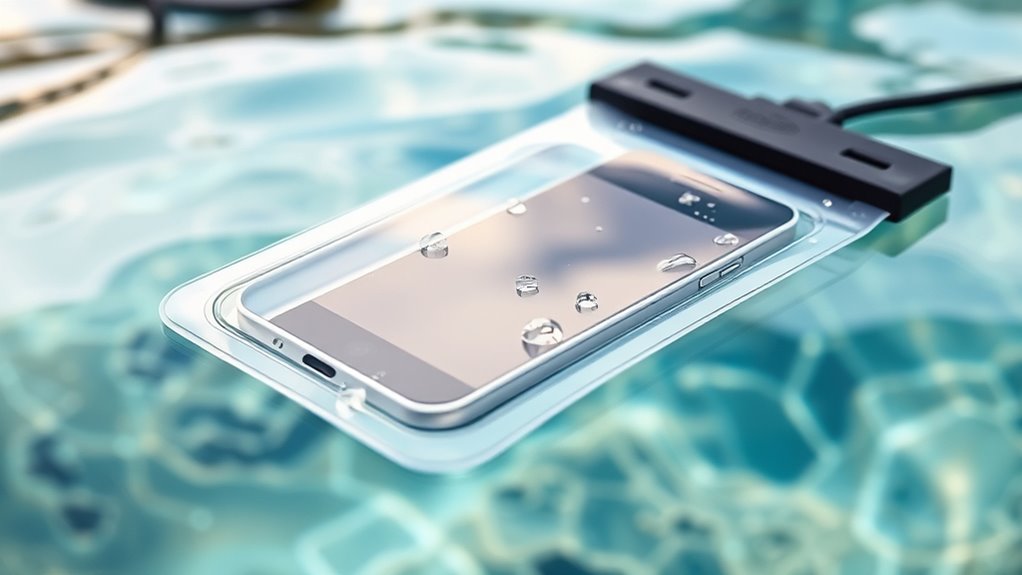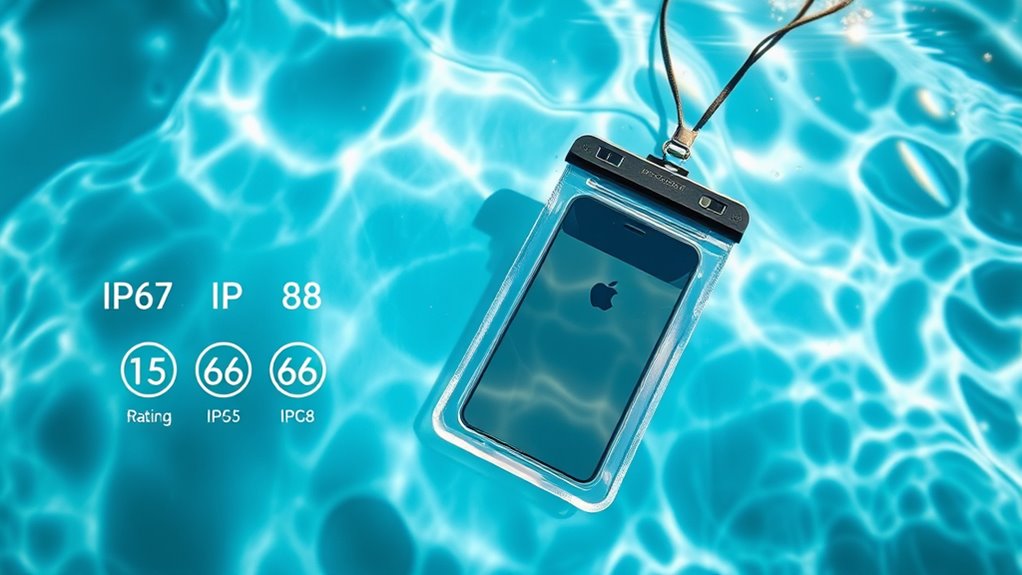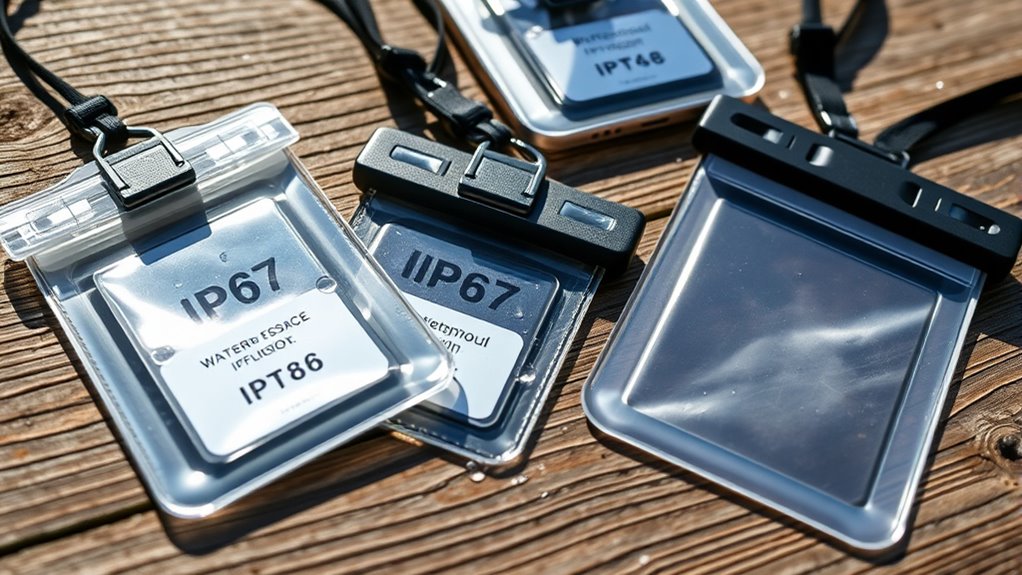IP ratings tell you how well your waterproof phone pouch shields against dust and water. They use a two-digit code, like IP67 or IP68, indicating protection levels. Higher numbers mean better resistance, but these ratings are tested under ideal conditions. To pick the best pouch, match its IP rating to your activity. Keep in mind, real-world performance can vary, so more details can help make sure you choose the right protection for your needs.
Key Takeaways
- IP ratings indicate the level of protection against solids and liquids, helping consumers choose appropriate waterproof pouches.
- The IP code’s two digits specify dust resistance (first digit) and water immersion capability (second digit).
- Common ratings like IP67 and IP68 signify suitability for temporary or prolonged water immersion, respectively.
- Higher IP ratings generally offer better protection but may increase pouch size and cost.
- Real-world performance depends on seal quality, usage conditions, and build durability beyond just IP ratings.
What Are IP Ratings and How Are They Determined?

IP ratings, also known as Ingress Protection ratings, help you understand how well a device is protected against solids and liquids. These ratings are determined through standardized testing conducted by manufacturers. The process involves exposing the device to specific levels of dust, dirt, and water under controlled conditions. The device’s ability to resist these elements is then assigned a two-digit number. The first digit indicates the level of protection against solids like dust, while the second digit reflects protection against liquids such as water. Higher numbers mean better protection. For example, an IP67 rating signifies dust resistance and the ability to withstand immersion in water up to one meter deep for 30 minutes. This systematic testing guarantees you know what level of protection your device offers. Understanding IP ratings helps consumers make informed decisions about device durability and waterproof capabilities, ensuring suitability for various environments. Additionally, knowing the specific IP rating can assist in determining whether a device is appropriate for activities like swimming or outdoor adventures. Recognizing the testing standards behind these ratings can further help in assessing device resilience in real-world settings, especially when considering exposure to water and other challenging conditions.
Understanding the IP Code Format and Its Significance

The IP code format provides a clear and standardized way to understand a device’s level of protection against solids and liquids. It consists of two digits: the first indicates protection against solids like dust, while the second shows protection against liquids such as water. Higher numbers mean better protection. For example, an IP68 rating means your device is dust-tight and can withstand prolonged water immersion. Knowing this format helps you quickly assess whether a phone pouch will meet your needs, especially if you’re exposed to dust, water, or moisture regularly. It’s important to pay attention to both digits, as a high rating in one area doesn’t necessarily mean the device is protected against everything. Understanding this code helps you make informed decisions about choosing the right waterproof pouch. Protection levels are standardized measures that ensure you get reliable protection based on your environment. Additionally, waterproof ratings can vary depending on how well the device maintains its seal under different conditions, and understanding the IP rating can help you determine the specific environments in which your device will remain protected. Recognizing the seal integrity of a device is crucial for ensuring consistent protection over time, especially if the device is subjected to rough handling or environmental stressors. Incorporating certified standards ensures that waterproof pouches meet industry benchmarks for durability and reliability.
Common IP Ratings for Waterproof Phone Pouches and Their Meanings

When choosing a waterproof phone pouch, understanding common IP ratings can help you determine the level of protection it offers. IP ratings indicate how well a pouch resists dust and water. For example, IP67 means the pouch is dust-tight and can be submerged up to 1 meter for 30 minutes. IP68 offers even better water resistance, suitable for continuous immersion. Here’s a quick reference:
| IP Rating | Dust Protection | Water Resistance Level |
|---|---|---|
| IP65 | Dust protected | Water jets, limited ingress |
| IP66 | Dust tight | Powerful water jets |
| IP67 | Dust tight | Temporary immersion |
| IP68 | Dust tight | Continuous immersion, specifics vary |
| IP69K | Dust tight | High-pressure, high-temperature water jets |
Additionally, understanding the IP rating system can help ensure you select a pouch that meets your specific needs for durability and water exposure. Recognizing how different waterproof standards apply can guide you in choosing the appropriate level of protection for various environments. Moreover, considering the specific environmental conditions in which you’ll use the pouch can help you select the most suitable IP rating to ensure your device remains safe. It is also important to consider the regulatory requirements that may apply depending on your region or activity, to ensure compliance and optimal protection. Being aware of decluttering strategies can also help you organize your gear and accessories efficiently, making your outdoor adventures or daily commutes more manageable.
Practical Tips for Choosing the Right Waterproof Pouch Based on IP Ratings

Choosing the right waterproof pouch depends on how you plan to use it, especially considering the level of water exposure you expect. If you’ll be near splashes or light rain, a pouch with a waterproof rating of IPX4 or IPX5 might suffice. For swimming, snorkeling, or heavy rain, look for IPX7 or IPX8 ratings, which offer higher protection. Also, consider the environment—saltwater, mud, or dust may require additional features beyond IP ratings. Check if the pouch provides secure sealing mechanisms, like waterproof zippers or snap-locks, to prevent accidental water ingress. Remember, higher IP ratings typically mean better protection, but they can also come with increased bulk or cost. Match the pouch’s rating to your activity level for ideal protection and usability. Ensuring your environmental considerations are aligned with your gear can significantly enhance your outdoor experience. Additionally, understanding the IP ratings can help you make an informed decision tailored to your specific needs. For example, some advanced models incorporate additional sealing features that provide extra security against water ingress in extreme conditions. Furthermore, staying informed about AI security advancements can help you protect your digital assets while enjoying outdoor adventures.
Limitations of IP Ratings and Additional Factors to Consider

While IP ratings provide a useful baseline for waterproof protection, they don’t tell the whole story. These ratings mainly measure a device’s resistance to water and dust under controlled conditions, but real-world situations can vary. Factors like water pressure, temperature, and duration of exposure can affect performance. For instance, a phone rated IP67 isn’t guaranteed to survive prolonged submersion or high-pressure water jets. Additionally, certifications don’t account for wear and tear, user handling, or manufacturing inconsistencies. You should also consider the seal quality of your waterproof pouch, how well it fits your phone, and whether it’s designed for specific activities like swimming or hiking. Relying solely on IP ratings can give a false sense of security—look at the overall build, reviews, and manufacturer guidelines for better protection. Furthermore, understanding the water resistance standards can help you choose a pouch suited to your specific needs, especially considering that some breeds, like the Black Golden Retriever, are known for their adaptability and resilience in different environments.
Frequently Asked Questions
Can a Pouch With a High IP Rating Still Be Damaged?
A pouch with a high IP rating provides excellent protection against water and dust, but it isn’t completely damage-proof. You might still damage your device if you expose it to extreme conditions, such as high-pressure water jets or prolonged submersion beyond the pouch’s limits. Always check the specific IP rating’s capabilities and avoid pushing the boundaries to ensure your phone stays safe in harsh environments.
How Often Should I Test My Waterproof Phone Pouch?
Ever find yourself wondering when to test your waterproof pouch? It’s a good idea to verify it before each trip to ensure it’s still secure, especially if you’ve dropped it or exposed it to harsh conditions. Regular testing, like a quick water resistance check monthly, can catch issues early. Remember, even high IP-rated pouches aren’t foolproof—routine tests keep your phone safe and your mind at ease.
Do IP Ratings Cover Protection Against Dust and Dirt?
IP ratings do cover protection against dust and dirt. The first digit in the rating indicates how well your device resists solids like dust, dirt, and debris. For example, an IP6X rating means your phone is dust-tight. So, if dust and dirt are concerns, look for a high first digit in the IP rating. This guarantees your device stays protected from particles that could cause damage or malfunction.
Are There Differences in Durability Between Brands With the Same IP Rating?
Brand battles bring differences in durability despite similar IP ratings. You might see sturdy seams, resilient materials, and reinforced seals vary from brand to brand. While the IP rating indicates water and dust resistance, quality construction makes a big difference in real-world toughness. You’ll notice some brands boast better build, boasting longer-lasting protection. So, don’t just rely on the rating—look for reviews, materials, and craftsmanship to find the most durable pouch for your needs.
How Does Temperature Affect the Waterproofing of Ip-Rated Pouches?
Temperature can impact the waterproofing of IP-rated pouches by affecting materials and seals. When it’s too hot, rubber and silicone may expand, potentially creating gaps or reducing seal integrity. Cold temperatures can make materials brittle, risking cracks or tears. You should avoid exposing your pouch to extreme temperatures for prolonged periods, as this can weaken its water resistance. Always check manufacturer guidelines for temperature limits to guarantee ideal protection.
Conclusion
Think of IP ratings as your shield in a storm—guiding you through unpredictable weather. While they provide a reliable map, remember that no shield is invincible. Your choice of waterproof pouch is like planting a sturdy tree—offering protection and peace of mind amid life’s tempests. Trust the ratings, but also listen to your instincts, and you’ll find the perfect companion to keep your phone safe, no matter what storms come your way.










